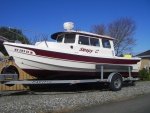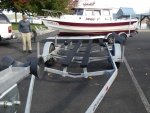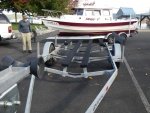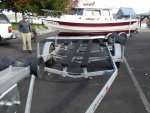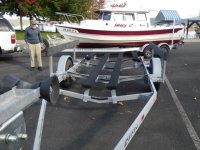I have a Pacific Tandem bunk trailer, galvanized, for my 22 Cruiser. When backing down the launch ramp I often have to back to where the rear pickup tires are into the water, almost to the bottom edge of the wheels. Sometimes I still have to work to get the boat to slide off the bunks, which usually means drive forward again, then back and stop quick to get the boat to slide back on the bunks before it will float off or float to where I can pull it off by hand.
My assessment is that the boat needs more water to float off, so I either need to back farther into the water, have a longer trailer tongue or have the boat sitting lower on the trailer so it will float sooner.
I have thought about a tongue or hitch extension, a sliding tongue extension permanently on the trailer, or…..
My current thinking is this. (Since the boat is going to be off the trailer for about a week getting bottom paint.) I would have a good opportunity to do some trailer work. I am looking at changing the height of the bunks above the frame and axels lower the bunks about 2 inches. It appears to me that there is room for that without adversely affecting the ground clearances adversely. (The brackets are made by Pacific on an individual basis so they don’t have a set for a 22 foot C-Dory in stock on the shelf, and they run about $28 each, so it is not an inexpensive job, and then there would be new stainless hardware and maybe a new carpet layer as well.
I’m wondering if anyone has done anything like this before? If anyone can see any problems I am going to run into before a actually get there? Or, if there is a better way to address this issue, what is it?
The reasoning for doing this is that now I am getting “dragging lines” or “slide lines” on the bottom from where it is sliding on the bunks (the two long inside ones), and I don’t want to be wearing off the bottom paint as it is softer than the gel coat. It seems like this would be a good time, and I would rather have it better than good, not just make do….
Harvey
SleepyC:moon
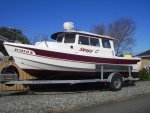
My assessment is that the boat needs more water to float off, so I either need to back farther into the water, have a longer trailer tongue or have the boat sitting lower on the trailer so it will float sooner.
I have thought about a tongue or hitch extension, a sliding tongue extension permanently on the trailer, or…..
My current thinking is this. (Since the boat is going to be off the trailer for about a week getting bottom paint.) I would have a good opportunity to do some trailer work. I am looking at changing the height of the bunks above the frame and axels lower the bunks about 2 inches. It appears to me that there is room for that without adversely affecting the ground clearances adversely. (The brackets are made by Pacific on an individual basis so they don’t have a set for a 22 foot C-Dory in stock on the shelf, and they run about $28 each, so it is not an inexpensive job, and then there would be new stainless hardware and maybe a new carpet layer as well.
I’m wondering if anyone has done anything like this before? If anyone can see any problems I am going to run into before a actually get there? Or, if there is a better way to address this issue, what is it?
The reasoning for doing this is that now I am getting “dragging lines” or “slide lines” on the bottom from where it is sliding on the bunks (the two long inside ones), and I don’t want to be wearing off the bottom paint as it is softer than the gel coat. It seems like this would be a good time, and I would rather have it better than good, not just make do….
Harvey
SleepyC:moon


